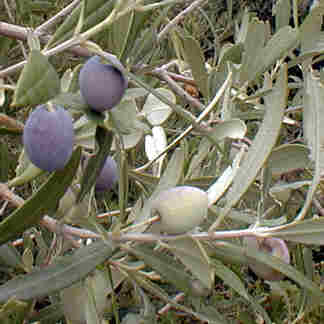
Plant Description
Caution & Interaction

Latin (botanical) name:
Olea Europaea
Common names: Olive Leaf, Olive Tree
Plant Description: The Olive tree is indigenous to the Levant, in the Eastern Mediterranean, but is now grown and used extensively throughout the entire Mediterranean region. The first Spanish settlers introduced the Olive tree to America. It is an evergreen tree growing up to 50 ft. in height with a spread of about 30 ft. It has a graceful, yet gnarled branch pattern. It has many thin branches with opposite branchlets. The leaves are opposite, as well, feather-shaped, or elliptic, and about 2-1/4" long. They are smooth, and pale green on top and silvery on the bottom which gives them a grayish-green hue. The bark of the tree is pale gray. Olive trees produce two different types of creamy white flowers-- one which contains both male and female parts, and the other, a staminate flower with stamens only. After about four years, the tree is mature enough to produce fruit. A green drupe which, when fully mature becomes very dark purple, is the fruit of the Olive tree. They can be either almost round to oval, and the fleshy part is filled with oil. It contains a single seed.
Medicinal Properties &Uses: Olive leaf extract has proven anti-viral, anti-bacterial, and anti-fungal properties. It provides a boost to immune function, fights infection, and increases resistance to disease. Clinical trials have shown Olive leaf extract to reduce blood pressure. It dilates the blood vessels so that blood may flow more easily throughout the system. As an antioxidant, Olive leaf extract protects those blood vessels from damage, and has been shown to be effective in protecting the heart from coronary occlusion. When taken over an extended period of time, it is believed to reverse arteriosclerosis. Olive leaves are astringent and antiseptic. Both the leaves and the bark have valuable febrifugal qualities. It is a useful aid in treating chronic fatigue syndrome as it rids patients of bacterial, fungal, parasitic and viral infections. The oil from the fruit is used as a natural laxative and disperser of acids. Used externally as a lubricant, it is effective in treating kidney and chest complaints, muscular and joint ailments, and typhoid and scarlet fevers. It also relieves pruritis, and calms the inflammation and pain of burns and insect bites.
Dosage: 20-40 drops in water or juice, 2-3 times daily or as needed. Shake well before using.
Cautions & Interactions: Keep out of reach of children.
Efficacy Studies & Other Clinical Data: Helpful Links:
Disclaimer (U.S. Only): These statements have not been evaluated by the FDA. These products are not intended to diagnose, cure, treat, or prevent any disease.
Common names: Olive Leaf, Olive Tree
Plant Description: The Olive tree is indigenous to the Levant, in the Eastern Mediterranean, but is now grown and used extensively throughout the entire Mediterranean region. The first Spanish settlers introduced the Olive tree to America. It is an evergreen tree growing up to 50 ft. in height with a spread of about 30 ft. It has a graceful, yet gnarled branch pattern. It has many thin branches with opposite branchlets. The leaves are opposite, as well, feather-shaped, or elliptic, and about 2-1/4" long. They are smooth, and pale green on top and silvery on the bottom which gives them a grayish-green hue. The bark of the tree is pale gray. Olive trees produce two different types of creamy white flowers-- one which contains both male and female parts, and the other, a staminate flower with stamens only. After about four years, the tree is mature enough to produce fruit. A green drupe which, when fully mature becomes very dark purple, is the fruit of the Olive tree. They can be either almost round to oval, and the fleshy part is filled with oil. It contains a single seed.
Medicinal Properties &Uses: Olive leaf extract has proven anti-viral, anti-bacterial, and anti-fungal properties. It provides a boost to immune function, fights infection, and increases resistance to disease. Clinical trials have shown Olive leaf extract to reduce blood pressure. It dilates the blood vessels so that blood may flow more easily throughout the system. As an antioxidant, Olive leaf extract protects those blood vessels from damage, and has been shown to be effective in protecting the heart from coronary occlusion. When taken over an extended period of time, it is believed to reverse arteriosclerosis. Olive leaves are astringent and antiseptic. Both the leaves and the bark have valuable febrifugal qualities. It is a useful aid in treating chronic fatigue syndrome as it rids patients of bacterial, fungal, parasitic and viral infections. The oil from the fruit is used as a natural laxative and disperser of acids. Used externally as a lubricant, it is effective in treating kidney and chest complaints, muscular and joint ailments, and typhoid and scarlet fevers. It also relieves pruritis, and calms the inflammation and pain of burns and insect bites.
Dosage: 20-40 drops in water or juice, 2-3 times daily or as needed. Shake well before using.
Cautions & Interactions: Keep out of reach of children.
Efficacy Studies & Other Clinical Data: Helpful Links:
Disclaimer (U.S. Only): These statements have not been evaluated by the FDA. These products are not intended to diagnose, cure, treat, or prevent any disease.